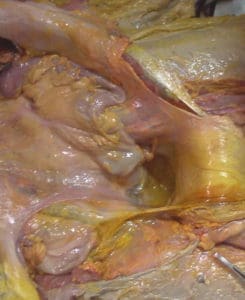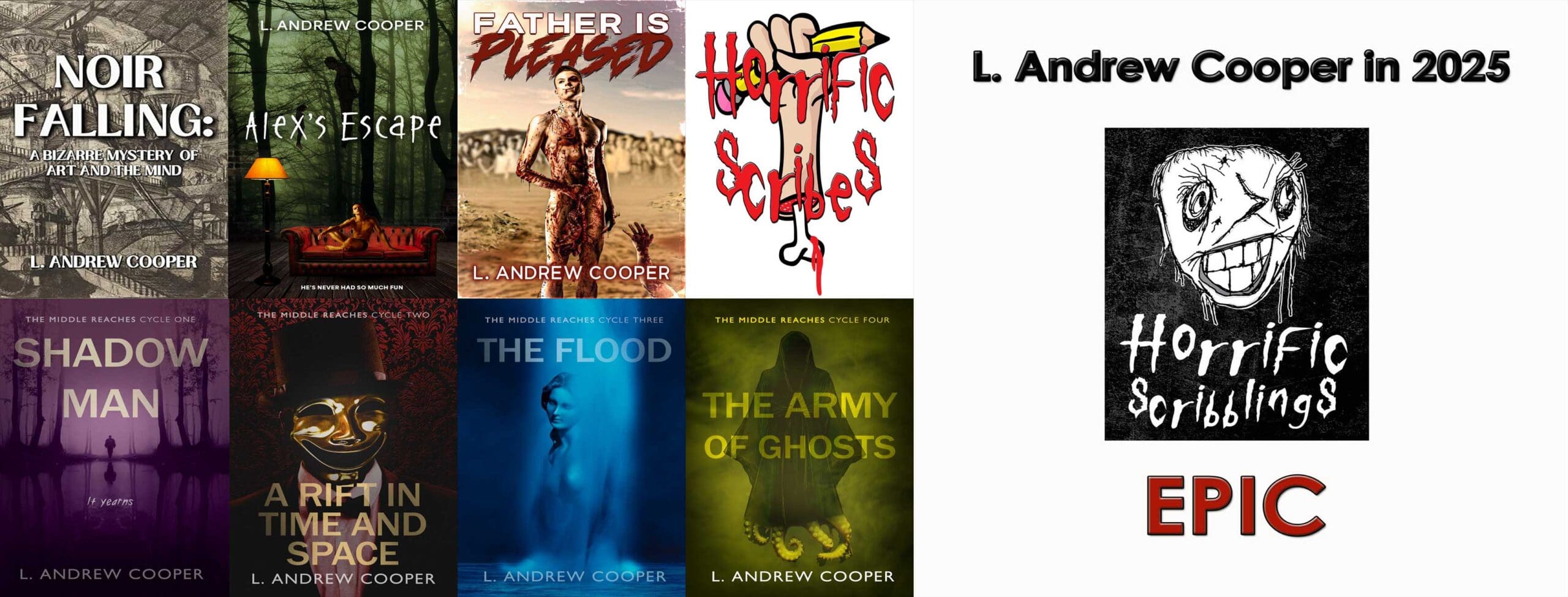Peritoneum, Horrors by L. Andrew Cooper
(Coming mid-May, 2016)
Back Cover Info:
Snaking through history—from the early-1900s cannibal axe-murderer of “Blood and Feathers,” to the monster hunting on the 1943 Pacific front in “Year of the Wolf,” through the files of J. Edgar Hoover for an “Interview with ‘Oscar,’” and into “The Broom Closet Where Everything Dies” for a finale in the year 2050—Peritoneum winds up your guts to assault your brain. Hallucinatory experiences redefine nightmare in “Patrick’s Luck” and “Eternal Recurrence of Suburban Abortion.” Strange visions of colors and insects spill through the basements of hospitals and houses, especially the basement that provides the title for “TR4B,” which causes visitors to suffer from “Door Poison.” Settings, characters, and details recur not only in these tales but throughout Peritoneum, connecting all its stories in oblique but organic ways. Freud, borrowing from Virgil, promised to unlock dreams not by bending higher powers but by moving infernal regions. Welcome to a vivisection. Come dream with the insides.


Contents
- Prologue, The Family Pet: Steven Marks awakes one morning to find his older brother Gordon in the back yard doing terrible things.
- Blood and Feathers: Dr. Allen V. Fincher recruits Elijah Eagleton from Harvard through a show of unnatural power, so Eli must show power of his own to prove his worth. Slaughter abounds.
- Leer Reel: Obsessed with Dr. Fincher, Louis Jardin describes life at the Whispering River mental hospital, especially the ritual murders and his ability to spy on people who read his writing.
- Year of the Wolf: Matilda Roan sends Louis Jardin, who becomes a wolf-like creature, into the World War 2 Battle of Tarawa, where he hunts soldiers on both sides before being destroyed.
- Interview with ‘Oscar,’ circa 1962: During an interview with an FBI agent, Oscar describes the fate of a small town known for harboring sinful lawbreakers in 1862 Kentucky.
- Patrick’s Luck: A family receives “help” at the Whispering River mental hospital, only to find they have become part of colorful and deadly experiments that evoke hallucinatory violence.
- Juicy the Liar: Matilda Roan inducts her new friend Melia into the Fincher circle, exploring cunnilingus, battle strategy, and a flying car.
- DNA: A survivalist’s well-trained son awakes in a giant aquarium filled with office cubicle dividers. Armed with a clipboard, he must face absurd monstrosities and find a way out.
- Lizard Chrome: An army of lizards that drain colors from what they touch invades a trendy city gathering place.
- David Langley and the Burglar: A burglar-philosopher, who wants to graduate to murder, breaks into a man’s house and discovers the man stuck to his ceiling.
- The Long Flight of Charlotte Radcliffe: A woman attempts reconciliation despite her traumatic past with her Uncle Henry, but he is once again trying to entrap her.
- The Road Thief: A boy loses his mother when a spectral man-shape menaces them on the highway. Years later, the man-shape reappears when strange people invade his workplace.
- Rudy Haskill’s Plan: Rudy performs an experiment involving the internet, a man, a woman, and mismatched fantasies.
- Jar of Evil: A jar of pure evil gets out of the lab and could infect the city!
- Bubble Girl: A group of kids discovers a little girl floating in a protected bubble on the playground. Is she a ghost? What mysteries does she hold?
- Eternal Recurrence of Suburban Abortion: A young woman goes to a notorious suburban house (TR4B) for an unusual medical procedure and ends up on a nightmarish journey.
- TR4B: The “Horror Mother” revisits the basement where her sons Steven and Gordon committed atrocities and faces supernatural tortures.
- Door Poison: A young couple visits notorious TR4B and enters a colorful but deadly video-game-like experience involving a floating head and a giant syringe.
- The Birds of St. Francis: Oscar meets with the Fincher circle (Elijah, Melia, and Jake) and causes history-changing disturbances involving the birds in Central Park, New York.
- The Broom Closet Where Everything Dies: Young Tim hunts the giant albino penguins from Poe/Lovecraft until Elijah recruits him—then his parents seem like better targets.

In Peritoneum, mass murder becomes a backdrop while cannibalism is a matter for casual conversation. Stories take place at different historical moments, but since some characters see the distant past as well as the future, anachronism permeates their thoughts. Characters can often hear each other’s thoughts, too, so perspectives become… cluttered. Endings do not flow from beginnings but erupt from nightmarish hints of possibility; cause and effect have lost explanatory power. Natural order—the order you would expect to find in a story—churns and dissolves. Peritoneum is such an unnatural book that I think I can fairly call it, as a whole, insane.
Surrender to insanity. The book wants to disturb you, to strike at your brain through your guts, to make you feel and think in unnatural ways. Peritoneum experiments with your insides by doing things you think it shouldn’t. Most horror at least gestures toward the forbidden, usually taboos related to sex and violence, and my stories do not hesitate to mention the unmentionable, both in passing and in graphic detail. The language is harsh; the imagery is harsher. Whether you prefer the fairly realistic narration of “Prologue: The Family Pet,” the reserved dialogue of “Interview with ‘Oscar,’” or the hallucinatory assault of “Eternal Recurrence of Suburban Abortion,” you will encounter an array of people—dead, dying, suffering, enjoying—and situations that refuse the types of answers you expect while providing other, darker answers.
Answers don’t always appear where you expect, either. While Peritoneum refuses many of storytelling’s natural orders, it develops its own systems, connecting its stories to one another in ways that make them interdependent. “Eternal Recurrence” and “TR4B” pick up on the characters and setting from “The Family Pet” and weave in and out of one another; “Door Poison” and “The Broom Closet Where Everything Dies” share a setting with “TR4B,” while “The Broom Closet” also connects to “DNA” and to “Blood and Feathers,” which shares characters with “Leer Reel,” “Year of the Wolf,” and especially “The Birds of St. Francis,” and so on. Fitting the stories together doesn’t create anything like a linear narrative or complete picture, but just as the type of bubble that appears briefly in “Blood and Feathers” seems finally, and inexplicably, to get its due in “Bubble Girl,” mysteries get bigger according to their own internal logics, threatening to explode.
The explosion and dissolution of bodies, minds, and relationships—family losses lead to madness and slaughter in “David Langley and the Burglar” and “The Road Thief”—make most of the stories pretty grim, but you’re allowed to laugh, too. The line between funny-weird and funny-ha-ha tends to vanish along with rationality. I hope you don’t take “Jar of Evil” or “Juicy the Liar” too seriously, although they may be too sick, infuriating, or off-key for actual laughter. When I put my arch-evil characters in a flying car, I am not wearing a straight face. Likewise, I giggle at the mayhem in “Lizard Chrome” and the machinations in “Rudy Haskill’s Plan.” I find the video-game inspired levels of “Patrick’s Luck” and “Door Poison” amusing, although I feel guilty admitting it (sick, sick, sick). Although the ending is ambiguous at best, I even feel some triumph in “The Long Flight of Charlotte Radcliffe,” for the eruption of insanity on that airplane is at least a pretty solution to one of the heroine’s problems. Absurd, irrational styles of narration have their outlets. Insanity isn’t all tragedy, all the time.
While Peritoneum has many ties to my other work, especially the conspiracies of Dr. Allen V. Fincher (and his friends Eli, Jake, Tildy, Louis, Melia, and Oscar), it is a universe unto itself, held together by a membrane of concepts and themes. The universe is like our own, I believe, in lacking coherent sense and values, but it fills the void with nightmares, an example I encourage you NOT to follow. Do not take anything in this book as advice. Do not emulate the characters or seek to replicate the impossible events. Instead, digest the nightmares as you will, making the experiences of insanity parts of yourself, and then lift your brain from the sewage into whatever light remains for you to imagine.



Comments are closed.